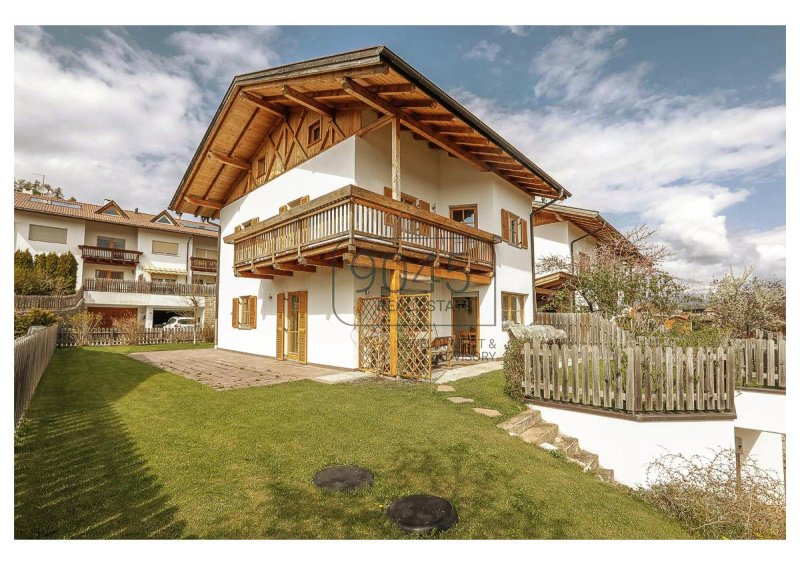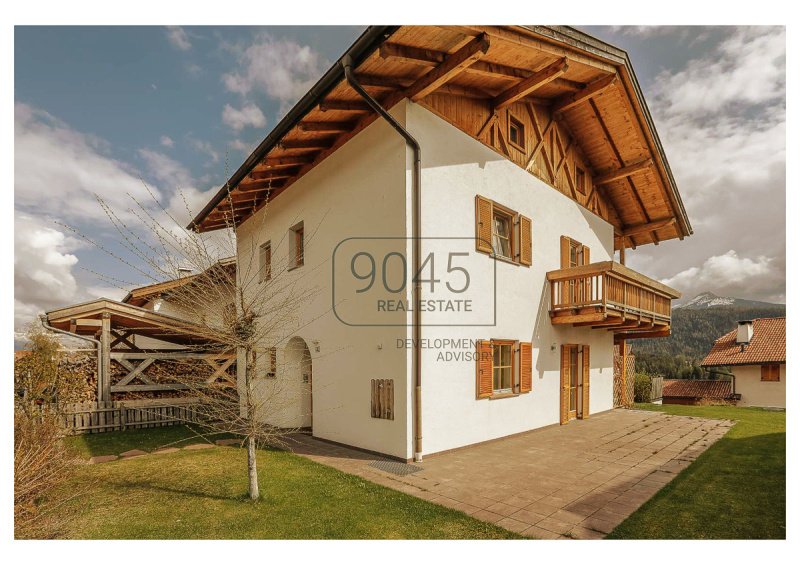$1,702,400 NZD
(950,000 €)
4 bedrooms villa, 232 m² Deutschnofen, Bolzano (province)
Description
Detached house in sunny Deutschnofen - South Tyrol
This detached house with garden is strategically located in Deutschnofen.
The basement consists of a spacious double garage, a laundry room and three cellar rooms.
On the second floor the house consists of: Entrance area, bathroom, office, living room with kitchen and the garden of over 240,00m².
The 1st floor consists of three bedrooms, two bathrooms and a spacious balcony.
On the 2nd and last floor there is a large room, a storage room and a bathroom.
We are looking forward to your concrete inquiry! nn Traces from the Mesolithic period on the Reiterjoch testify that people lived in the municipality as early as 5000 to 5700 BC. A prehistoric hill fort stood on Burgstallegg to the east of Platten. Otherwise, the area was still largely wooded and uninhabited.
Around 1200, the settlement of Nova Ponente/Deutschnofen was probably complete, as by 1275 at the latest, people had already migrated from the area to the Fersental valley and the area of Piné in Trentino. This means that the land for the construction of new farms had already become scarce. As early as 1434, the "lewtte und gemainschaft von Tewtschenofen" appeared as an independent village cooperative in a customs dispute with the noble Botsch family.
There are still around 260 farms in the Deutschnofen area, spread across the old districts of Platz, Prent, Zelg, Unterkirch and Bühl. The number of farms that are no longer farmed is increasing. Agriculture is of great importance to the history of the municipality. Since the High Middle Ages, the population on the Deutschnofen plateau has been almost exclusively rural. The logs, which were transported in large quantities from the Deutschnofen farm, were used as firewood by the citizens of Bolzano and as vineyard wood by the winegrowers. The columns on which two lions watch over St. Mark's Square in Venice are said to have been made from wood from the Deutschnofener Hof. In 1614, wood from Deutschnofen was supplied for the roof truss of the Basilica of San Petronio in Bologna. In the early days, the Deutschnofener Hof was managed by noblemen. The most important of these were the Lords of Niederthor. In 1849, the court of Neu Ponente was incorporated into the judicial district of Bolzano.
Mining was also important in the 15th and 16th centuries and later in the 19th century. After the Second World War, economic life in the municipality changed completely. At the beginning of the 1950s, the timber trade initially flourished, followed by crafts and construction.
The Brantental valley used to be the most important connection to Bolzano. Mills, sawmills and inns were lined up there. In 1850, plans were made to extend the road, but the project failed, as it did at the beginning of the First World War. In 1860, the road through the Val d'Ega was completed, which is still the most important traffic artery today, while the Val di Brantino lost its importance and was never expanded. Translated with www.DeepL.com/Translator (free version) nn + Heating with gas
+ Energy class D
+ Year of construction 2002 nn All information is subject to change, non-binding, without guarantee and based on information provided to us by our customer. We assume no liability for completeness, accuracy and timeliness. We reserve the right of mediation.
We would like to point out that, in the event of success, our business is subject to a brokerage and/or commission. In the event of a sale, the commission is 4.88% of the notarized purchase price. Our general terms and conditions apply.
This detached house with garden is strategically located in Deutschnofen.
The basement consists of a spacious double garage, a laundry room and three cellar rooms.
On the second floor the house consists of: Entrance area, bathroom, office, living room with kitchen and the garden of over 240,00m².
The 1st floor consists of three bedrooms, two bathrooms and a spacious balcony.
On the 2nd and last floor there is a large room, a storage room and a bathroom.
We are looking forward to your concrete inquiry! nn Traces from the Mesolithic period on the Reiterjoch testify that people lived in the municipality as early as 5000 to 5700 BC. A prehistoric hill fort stood on Burgstallegg to the east of Platten. Otherwise, the area was still largely wooded and uninhabited.
Around 1200, the settlement of Nova Ponente/Deutschnofen was probably complete, as by 1275 at the latest, people had already migrated from the area to the Fersental valley and the area of Piné in Trentino. This means that the land for the construction of new farms had already become scarce. As early as 1434, the "lewtte und gemainschaft von Tewtschenofen" appeared as an independent village cooperative in a customs dispute with the noble Botsch family.
There are still around 260 farms in the Deutschnofen area, spread across the old districts of Platz, Prent, Zelg, Unterkirch and Bühl. The number of farms that are no longer farmed is increasing. Agriculture is of great importance to the history of the municipality. Since the High Middle Ages, the population on the Deutschnofen plateau has been almost exclusively rural. The logs, which were transported in large quantities from the Deutschnofen farm, were used as firewood by the citizens of Bolzano and as vineyard wood by the winegrowers. The columns on which two lions watch over St. Mark's Square in Venice are said to have been made from wood from the Deutschnofener Hof. In 1614, wood from Deutschnofen was supplied for the roof truss of the Basilica of San Petronio in Bologna. In the early days, the Deutschnofener Hof was managed by noblemen. The most important of these were the Lords of Niederthor. In 1849, the court of Neu Ponente was incorporated into the judicial district of Bolzano.
Mining was also important in the 15th and 16th centuries and later in the 19th century. After the Second World War, economic life in the municipality changed completely. At the beginning of the 1950s, the timber trade initially flourished, followed by crafts and construction.
The Brantental valley used to be the most important connection to Bolzano. Mills, sawmills and inns were lined up there. In 1850, plans were made to extend the road, but the project failed, as it did at the beginning of the First World War. In 1860, the road through the Val d'Ega was completed, which is still the most important traffic artery today, while the Val di Brantino lost its importance and was never expanded. Translated with www.DeepL.com/Translator (free version) nn + Heating with gas
+ Energy class D
+ Year of construction 2002 nn All information is subject to change, non-binding, without guarantee and based on information provided to us by our customer. We assume no liability for completeness, accuracy and timeliness. We reserve the right of mediation.
We would like to point out that, in the event of success, our business is subject to a brokerage and/or commission. In the event of a sale, the commission is 4.88% of the notarized purchase price. Our general terms and conditions apply.
Details
- Property TypeVilla
- ConditionN/A
- Living area232 m²
- Bedrooms4
- Bathrooms4
- Energy Efficiency Rating
- Reference6969-LIF20
Distance from:
Distances are calculated in a straight line
- Airports
- Public transport
- Highway exit10.4 km
- Hospital12.7 km - Ospedale di Fiemme
- Coast131.2 km
- Ski resort5.5 km
What’s around this property
- Shops
- Eating out
- Sports activities
- Schools
- Pharmacy1.8 km - Pharmacy - Apotheke Deutschnofen
- Veterinary8.1 km - Veterinary - Sottomonte
Information about Deutschnofen
- Elevation1357 m a.s.l.
- Total area112.49 km²
- LandformInland mountain
- Population4029
Contact Agent
Dr. - Max - str. 8, Grünwald,
+49 151 11560000 / +39 333 9340000
What do you think of this advert’s quality?
Help us improve your Gate-away experience by giving a feedback about this advert.
Please, do not consider the property itself, but only the quality of how it is presented.


